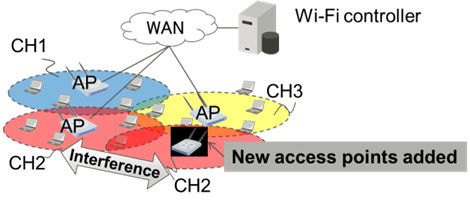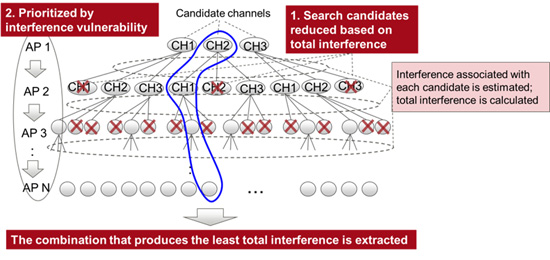Kawasaki, Japan, September 09, 2015
Fujitsu Laboratories Ltd. today announced that it has developed automatic channel-assignment technology that quickly reduces radio-wave interference, a cause of poor throughput in large-scale wireless LAN systems.
In order to maintain the network environments of enterprise networks, stadiums and other venues, multiple access points are required, and in such wireless LAN systems, many of these access points are in close proximity to each other. Previously it was difficult to perform the real-time calculations required for access-point channel reassignment that limits radio-wave interference.
Fujitsu has now developed channel-assigning technology that takes less than one minute to automatically calculate the assignment of channels with low interference in a Wi-Fi system comprising hundreds of access points.
Quickly assigning channels so as to avoid interference will help Wi-Fi system administrators to more easily deliver stable wireless communications even within extensive Wi-Fi systems consisting of many access points, such as in enterprise networks, stadiums or other locations.
Details of this technology are being presented at the IEICE Society Conference 2015, opening Tuesday, September 8, at Tohoku University in Sendai, Japan.
Background
Wireless LANs can be set up easily without a license, which has enabled them to be put into common use. But as Wi-Fi is used more widely, more access points are put into service, and different Wi-Fi networks may overlap, making radio-wave interference a growing problem.
 Figure 1: Wi-Fi system schematic
Figure 1: Wi-Fi system schematic
Issues
Placing a new Wi-Fi access point near an existing one results in radio-wave interference that did not exist when the original Wi-Fi system was first set up, causing diminished throughput. In order to resolve this interference, neighboring access points need to use channels with different frequencies. But as the number of access points grows, determining a combination of channels for the number of different frequencies becomes a complex problem, and reassigning channels in a short time following the occurrence of interference has been difficult.
While most access points on the market today include channel-selection functions, these operate on the principle of subsequent access points acquiring unused channels, so in a situation where multiple neighboring access points are using all channels, there is no way to choose a different channel, and throughput suffers.
There are known techniques for optimizing the combination of channels, but because the computational load increases against the cube of the number of access points, in environments with hundreds of access points, such as stadiums, these computations can take more than six hours, meaning these techniques are impractical for channel reassignments.
About the Technology
Fujitsu has developed technology that can reassign channels in response to radio-wave interference that occurs when the configuration of access points changes, within or outside the Wi-Fi system (Figure 2).
Key features of the technology are as follows.
1. Reduces the number of search candidates based on total interference
This technology searches for the best channel assignments while assigning candidate channels for each access point, in order. In this process, the interference associated with each candidate channel is estimated, the total interference is calculated, and candidates are partially eliminated. This process is applied to every access point, and the combination of channels that results in the least interference is used. With this approach to reducing interference, the computational load increases with the square of the number of access points. This represents a considerable reduction compared to the existing method, which increases with the cube of the number of access points.
2. Priority ordering based on vulnerability to interference
Each access point's vulnerability to interference is calculated based on the strength of the signal received by adjacent access points, and those access points that are most vulnerable to interference are given priority in channel assignments. Prioritizing access points that are vulnerable to interference reduces total interference throughout the system.
 Figure 2: How candidate channels are chosen to minimize interference
Figure 2: How candidate channels are chosen to minimize interference
Larger View (109 KB)
Results
In simulations to assess the technology's effectiveness, it was found to increase average throughput by up to 15% compared to the existing widely used channel-selection functions of individual access points. In addition, this technology was found to improve throughput for low-throughput access points (those in the bottom 1% of throughput) up to two-fold. Compared to existing channel-combination optimization methods, computation times were shortened to a fraction of the number of access point units to quickly reduce radio-wave interference. For example, in a system with 400 access points, computation time takes 1/400th as long as previously required.
This means that even in a Wi-Fi environment with hundreds of access points, such as an office or stadium, channels can be reassigned in less than one minute to limit interference, and even with changes in the environment, users can enjoy dependable access to the network.
Future Plans
Fujitsu is continuing to improve the performance of channel-assignment technology and is conducting operational tests, with the goal of practical implementations during fiscal 2016.
![]() E-mail: pr-wlan-ca@ml.labs.fujitsu.com
E-mail: pr-wlan-ca@ml.labs.fujitsu.com
